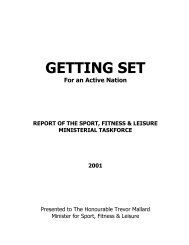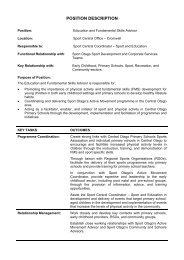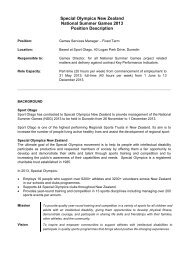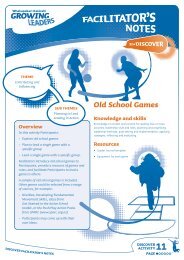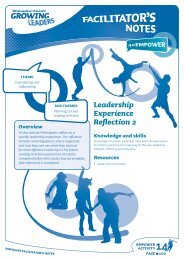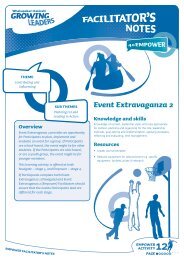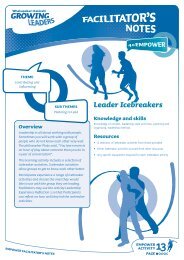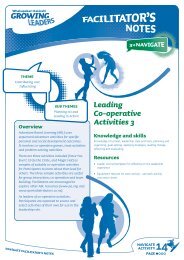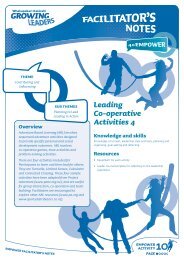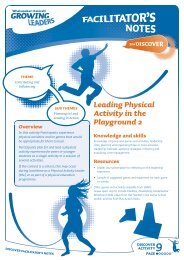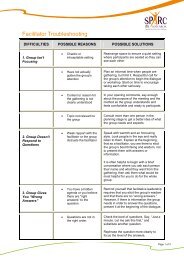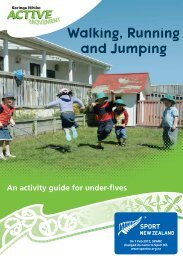Outdoor Activities Guidelines for Leaders - Sport New Zealand
Outdoor Activities Guidelines for Leaders - Sport New Zealand
Outdoor Activities Guidelines for Leaders - Sport New Zealand
Create successful ePaper yourself
Turn your PDF publications into a flip-book with our unique Google optimized e-Paper software.
<strong>Outdoor</strong> <strong>Activities</strong><br />
<strong>Guidelines</strong> <strong>for</strong> <strong>Leaders</strong><br />
On 1 Feb 2012, SPARC<br />
changed its name to <strong>Sport</strong> NZ.<br />
www.sportnz.org.nz
Foreword<br />
Foreword <strong>for</strong> <strong>Outdoor</strong> <strong>Activities</strong> – <strong>Guidelines</strong> <strong>for</strong> <strong>Leaders</strong><br />
In <strong>New</strong> <strong>Zealand</strong> we are lucky enough to live in a large adventure<br />
access to rivers, lakes, the sea, mountains, bush, the conservatio<br />
allowing us to explore and challenge ourselves in the great outdo<br />
Photo credit on cover: John Kapa; this page: Barry Daniell<br />
Recreation is one of five key pillars outlined in SPARC’s strategic<br />
see a recreation sector that is delivering quality experiences to t<br />
more people are encouraged to participate.<br />
SPARC’s first priority in recreation is to outdoor recreation, to de<br />
have made in this area.<br />
We will encourage and enable more people to participate by sup<br />
<strong>for</strong>mal and in<strong>for</strong>mal opportunities in recreation. We want to see<br />
participating in recreation, especially outdoor recreation.<br />
Helping in this work is the Sir Edmund Hillary <strong>Outdoor</strong> Recreatio<br />
make up the council have wide‐ranging skills, and the enthusiasm<br />
council looks to advise SPARC on strategic and investment decisi<br />
recreation.<br />
In <strong>New</strong> <strong>Zealand</strong> we are lucky enough to live in a large<br />
adventure playground. We have easy access to rivers,<br />
lakes, the sea, mountains, bush, the conservation<br />
estate and farmland – allowing us to explore and<br />
challenge ourselves in the great outdoors.<br />
Recreation is one of five key pillars outlined in <strong>Sport</strong><br />
and Recreation <strong>New</strong> <strong>Zealand</strong>’s (SPARC’s) strategic plan<br />
2009-2015. We want to see a recreation sector that is<br />
delivering quality experiences to those taking part, so<br />
that more people are encouraged to participate.<br />
SPARC’s first priority in recreation is to outdoor<br />
recreation, to deliver on the investment we have made<br />
in this area.<br />
We will encourage and enable more people to<br />
participate by supporting a diverse range of <strong>for</strong>mal<br />
and in<strong>for</strong>mal opportunities in recreation. We want to<br />
see more young people participating in recreation,<br />
especially outdoor recreation.<br />
Helping in this work is the Sir Edmund Hillary <strong>Outdoor</strong><br />
Recreation Council. The experts that make up the<br />
council have wide-ranging skills, and the enthusiasm<br />
<strong>for</strong> the task ahead as the council looks to advise<br />
SPARC on strategic and investment decisions relating<br />
to outdoor recreation.<br />
In 2007, <strong>Sport</strong> and Recreation <strong>New</strong> <strong>Zealand</strong> (SPARC) led a review<br />
sector. The 2007 SPARC-led outdoor recreation review<br />
highlighted the importance of maintaining skills and<br />
Findings understanding from that of outdoor review etiquette included and concerns knowledge that changes in par<br />
of about skills and the environment.<br />
a decline in understanding about outdoor etiquette<br />
environment.<br />
Much of the participation in outdoor recreation is<br />
unstructured and in<strong>for</strong>mal, making it important <strong>for</strong><br />
good in<strong>for</strong>mation to be readily available.<br />
Much of the participation in outdoor recreation is unstructur<br />
important This is where <strong>for</strong> good this resource in<strong>for</strong>mation <strong>Outdoor</strong> to <strong>Activities</strong> be readily – available.<br />
<strong>Guidelines</strong> <strong>for</strong> <strong>Leaders</strong> is proving valuable. It is <strong>for</strong><br />
outdoor instructors, teachers, youth group leaders<br />
This is where this resource <strong>Outdoor</strong> <strong>Activities</strong> – <strong>Guidelines</strong> <strong>for</strong> Lea<br />
and guides who are aiming to ensure participants in<br />
It is outdoor <strong>for</strong> outdoor recreation instructors, enjoy the teachers, experience. youth group leaders and g<br />
ensure participants in outdoor recreation enjoy the experience.<br />
It outlines accepted practice <strong>for</strong> running a wide variety<br />
It outlines of outdoor accepted activities. practice <strong>for</strong> running a wide variety of outdoo<br />
have I congratulate collaborated the to individuals produce and this organisations document by which providing in<strong>for</strong>m<br />
have collaborated to produce this document. It is an<br />
It is important essential resource resource <strong>for</strong> the <strong>for</strong> outdoor all those recreation leading sector. activities in the ou<br />
Peter Miskimmin<br />
Peter Chief Miskimmin Executive, <strong>Sport</strong> and Recreation <strong>New</strong> <strong>Zealand</strong><br />
Chief Executive, <strong>Sport</strong> and Recreation <strong>New</strong> <strong>Zealand</strong>
OUTDOOR ACTIVITIES – GUIDELINES FOR LEADERS 1<br />
Contents<br />
Section A: General guidelines<br />
Introduction.................................................................................................................................................... 2<br />
Definitions....................................................................................................................................................... 4<br />
Operating values............................................................................................................................................ 5<br />
Code of ethics............................................................................................................................................. 5<br />
Cultural values............................................................................................................................................ 5<br />
Environmental management........................................................................................................................ 6<br />
Employing an outdoor leader........................................................................................................................ 8<br />
Competencies and attributes....................................................................................................................... 8<br />
Qualifications.............................................................................................................................................. 9<br />
Logbooks.................................................................................................................................................. 12<br />
Be<strong>for</strong>e the activity........................................................................................................................................ 13<br />
Planning.................................................................................................................................................... 13<br />
Contracting an outdoor provider............................................................................................................... 13<br />
Briefing..................................................................................................................................................... 15<br />
Alcohol and other drugs............................................................................................................................ 16<br />
Ratios........................................................................................................................................................ 16<br />
During the activity........................................................................................................................................ 19<br />
Warm-up.................................................................................................................................................. 19<br />
Sequencing............................................................................................................................................... 19<br />
Activity levels............................................................................................................................................. 19<br />
Communications....................................................................................................................................... 19<br />
After the activity.......................................................................................................................................... 21<br />
Debriefing................................................................................................................................................. 21<br />
Reporting.................................................................................................................................................. 21<br />
Evaluating................................................................................................................................................. 22<br />
A team ef<strong>for</strong>t............................................................................................................................................ 23<br />
Reference group........................................................................................................................................ 23
2<br />
SECTION A<br />
Introduction<br />
People go into the outdoors <strong>for</strong> various reasons:<br />
recreation, health and well-being, education,<br />
conservation, and appreciation of the environment.<br />
<strong>Outdoor</strong> activities are an exciting<br />
means of providing opportunities <strong>for</strong><br />
huge learning and personal growth.<br />
different ways of conducting activities. It is not always<br />
appropriate to take a prescriptive approach to leading<br />
outdoor activities. Sometimes, codes of practice exist<br />
with a legislative basis. These codes mandate practices<br />
rather than provide guidelines. Usually, national<br />
organisations agree on a range of acceptable practices<br />
to run an activity safely and the guidelines in this<br />
resource outline these practices.<br />
These opportunities involve risk, which is an integral<br />
and positive part of outdoor activities. Managing<br />
the balance of risk and safety is a dilemma <strong>for</strong> those<br />
people who govern, manage and instruct outdoor<br />
activities. Keeping up to date with current, accepted<br />
practice in managing this balance is a challenge which<br />
this resource addresses.<br />
Who are these guidelines <strong>for</strong>?<br />
These guidelines are <strong>for</strong> <strong>New</strong> <strong>Zealand</strong> outdoor leaders,<br />
including volunteer and employed instructors, aspiring<br />
instructors, teachers, youth group leaders, club<br />
trip leaders, and guides. Governors, managers and<br />
participants of outdoor programmes may also find the<br />
guidelines useful.<br />
The resource outlines guidelines <strong>for</strong> a wide variety of<br />
outdoor activities, including some activities that people<br />
commonly access through commercial providers. You<br />
should also refer to:<br />
> Haddock, C. (2004). <strong>Outdoor</strong> safety –<br />
risk management <strong>for</strong> outdoor leaders.<br />
> Ministry of Education, (2002). Safety<br />
and EOTC. A good practice guide <strong>for</strong><br />
<strong>New</strong> <strong>Zealand</strong> schools. (From September<br />
2009, this publication will be replaced by<br />
EOTC <strong>Guidelines</strong>: Bringing the Curriculum<br />
Alive.)<br />
Current, accepted practice<br />
These guidelines document current, accepted practice.<br />
However, accepted practice evolves. Accepted practice<br />
in the past may not be current, accepted practice, and<br />
these guidelines may not be future, accepted practice.<br />
Current, accepted practice in outdoor activities is often<br />
difficult to define. Not only are practices and standards<br />
evolving, practitioners often debate the merits of<br />
Organisations should be able to<br />
demonstrate that their activities<br />
follow relevant codes of practice<br />
or current, accepted practice.<br />
If there are no <strong>for</strong>mal, national guidelines <strong>for</strong> specific<br />
activities, e.g. canyoning, organisations should<br />
establish that their practices are consistent with those<br />
of their professional peers.<br />
Some publications use the term ‘best practice’ to<br />
describe current, accepted practice.<br />
Are qualifications required?<br />
Safe practices are based on quality systems and<br />
the competence of outdoor leaders. Qualifications,<br />
coupled with logged, recent experience, are a measure<br />
of such competence.<br />
Increasingly, qualifications are available <strong>for</strong> outdoor<br />
leaders. Depending on the activity, qualifications are<br />
regulated and mandatory, qualifications are standard<br />
but have no regulatory body or, in some activities,<br />
they are uncommon.<br />
Despite these variations, there is a trend towards<br />
outdoor leaders holding qualifications that provide<br />
an independent assessment of competence to<br />
current, accepted practice. These include generic<br />
risk management, first aid, and activity-specific<br />
qualifications. This trend is likely to continue.<br />
Organisations and individuals should prepare <strong>for</strong> a<br />
future where there are higher expectations of training<br />
and qualification requirements.<br />
The qualifications referred to in these guidelines are<br />
usually recommended outdoor leader requirements,<br />
although some are mandatory. Sometimes people<br />
can demonstrate equivalent knowledge and skills (see<br />
Definitions: Equivalence).
OUTDOOR ACTIVITIES – GUIDELINES FOR LEADERS 3<br />
How were the guidelines<br />
compiled?<br />
National organisations usually contributed each<br />
activity’s guidelines.<br />
When an activity has no national organisation, local<br />
organisations and practitioners provided in<strong>for</strong>mation.<br />
Sometimes, public documents were the source of<br />
in<strong>for</strong>mation and, whenever possible, practitioners<br />
reviewed the drafts.<br />
The result is that, thanks to many people’s time and<br />
expertise, this resource attempts to reflect the various<br />
<strong>New</strong> <strong>Zealand</strong> outdoor communities’ accepted practice<br />
in 2005.<br />
The first printing of <strong>Outdoor</strong> <strong>Activities</strong>: <strong>Guidelines</strong><br />
<strong>for</strong> <strong>Leaders</strong> (2005) was very well received by<br />
the outdoor community. Hard copies of the<br />
publication sold out in January 2009. With the<br />
need <strong>for</strong> a reprint, the decision was made to<br />
conduct a review. You will find updated contact<br />
details, changes to qualifications and unit<br />
standards and minor amendments to text.<br />
Thanks to Lawrie Stewart, SPARC and to all those<br />
who freely gave of their time in the course of this<br />
review.<br />
This is a ‘living document’, so if you have any<br />
feedback please in<strong>for</strong>m <strong>Outdoor</strong>s <strong>New</strong> <strong>Zealand</strong>:<br />
www.outdoorsnz.org.nz<br />
Garth Gulley<br />
<strong>Outdoor</strong> Safety Programme Manager<br />
<strong>Outdoor</strong>s <strong>New</strong> <strong>Zealand</strong><br />
October 2009<br />
To order copies of this publication, go to the<br />
Resources page of the Knowledge Centre at:<br />
www.outdoorsnz.org.nz<br />
This publication can also be downloaded from the<br />
SPARC website: www.sparc.org.nz by searching<br />
<strong>for</strong> the publication title.
4<br />
SECTION A<br />
Definitions<br />
Assistant Leader<br />
A person who leads, or supervises, an activity whilst<br />
under the direct supervision of a more senior person<br />
and operating within organisational guidelines.<br />
Immediate support and intervention is available.<br />
Competencies<br />
Qualifications, knowledge and skills of outdoor leaders<br />
to deal effectively with the demands placed on them<br />
by the activity, people, equipment and environment.<br />
Currency<br />
<strong>Outdoor</strong> leaders use current, accepted practices.<br />
Currency assumes that practices continuously evolve<br />
and that outdoor leaders who operate out of the<br />
mainstream, or who do not have logged records of<br />
recent, successful experiences, may not operate to<br />
accepted standards.<br />
One measure of currency is membership of a<br />
professional association, e.g. Education <strong>Outdoor</strong>s<br />
<strong>New</strong> <strong>Zealand</strong> (EONZ), <strong>New</strong> <strong>Zealand</strong> Mountain Safety<br />
Council (NZMSC), or <strong>New</strong> <strong>Zealand</strong> <strong>Outdoor</strong> Instructors<br />
Association (NZOIA).<br />
Equivalency<br />
An alternative to a qualification which indicates that<br />
an outdoor leader meets the requirements listed in the<br />
relevant qualification’s syllabus.<br />
Emergency plan<br />
A set course of actions to respond to an incident.<br />
<strong>Guidelines</strong><br />
Recommended practices that outdoor leaders<br />
should follow.<br />
When an organisation or outdoor leader departs from<br />
guidelines, you should document the reasons and seek<br />
peer review.<br />
Incident<br />
An undesired event that could or does result in a loss.<br />
The loss may involve harm to people, damage to<br />
property or the environment and/or loss to process. 1<br />
The loss may be a fatality, injury, illness, near miss, or<br />
a combination of these events.<br />
<strong>Outdoor</strong> leader<br />
This is a generic term to describe someone who leads,<br />
or supervises, an activity. There are various levels of<br />
outdoor leadership ranging from those who are closely<br />
supervised through to independent instructors and<br />
guides. This person has the relevant qualifications and/<br />
or competence and experience to facilitate participants<br />
in gaining knowledge, attitude and skills in or through<br />
those activities.<br />
Policy<br />
Established practices or rules that outdoor leaders<br />
must follow. Policies are often <strong>for</strong>med from legislation<br />
but they are usually specific to an organisation.<br />
Qualification<br />
A competency award in a specific outdoor activity.<br />
Risk<br />
The potential to gain or lose something of value.<br />
The presence of risk creates uncertainty. Potential<br />
losses may include physical, environmental, mental,<br />
social or financial losses; potential gains may include<br />
knowledge, skills and attitudes to assist people to<br />
achieve their potential. (Haddock, C. 2004).<br />
Safety plan<br />
A set of actions to manage risk.<br />
This should be a written document. It may have<br />
other names, e.g. safety management plan, safety<br />
action plan (SAP), safe operating procedures (SOP),<br />
risk analysis management system (RAMS), and health<br />
and safety manual. Depending on what they contain,<br />
these documents may be one part only of the risk<br />
management plan.<br />
Health and safety legislation requires organisations to:<br />
> Take all practicable steps to ensure safety.<br />
> Identify hazards and mitigate them.<br />
> Develop emergency procedures.<br />
> Train employees.<br />
> Register incidents.<br />
1 Bird, F., & Germain, G., (1996). Practical loss control leadership: the conservation<br />
of people, property, process and profits 4th ed. USA: Det Norske Veritas
OUTDOOR ACTIVITIES – GUIDELINES FOR LEADERS 5<br />
Operating values<br />
Photo credit: Tihoi Venture School<br />
Code of ethics<br />
Numerous codes of ethics or conduct are applicable to<br />
outdoor leaders. You should check the codes relevant<br />
to you and work to them.<br />
The following organisations have examples of<br />
these codes:<br />
> <strong>New</strong> <strong>Zealand</strong> Mountain Safety Council<br />
www.mountainsafety.org.nz<br />
> <strong>New</strong> <strong>Zealand</strong> <strong>Outdoor</strong> Instructors Association<br />
www.nzoia.org.nz<br />
> <strong>New</strong> <strong>Zealand</strong> Teachers Council<br />
www.teacherscouncil.govt.nz<br />
> <strong>Outdoor</strong> Safety Institute www.risk.net.nz<br />
> Tourism Industry Association <strong>New</strong> <strong>Zealand</strong><br />
www.tianz.org.nz<br />
Cultural values<br />
Màori<br />
In Màori creation stories, the earth is Papatuanuku:<br />
the Earth Mother.<br />
Like a mother, the earth supports and nourishes us.<br />
Màori identity is linked to the land, including the<br />
mountains, rivers, lakes and seas. Màori genealogy or<br />
whakapapa begins with the land.<br />
The significance of land revolves around the word<br />
‘whenua’, which can be defined in the physical sense<br />
as the placenta.<br />
In the physical sense, as the placenta nourishes our<br />
development in the womb, so does the land nourish<br />
our development in the natural world. Whenua can<br />
there<strong>for</strong>e be defined as land, and the people who<br />
guard and protect it are tangata whenua – people<br />
of the land.<br />
Photo credit: Education <strong>Outdoor</strong>s NZ (EONZ)<br />
In the Màori world view, the unbreakable bond<br />
between mother and child is exactly the same<br />
between the land and the people. The responsibility<br />
to protect the land is a responsibility that is taken<br />
seriously to ensure that Papatuanuku continues to be<br />
able to support and nourish life through her rivers,<br />
<strong>for</strong>ests and oceans, which are regarded as taonga<br />
(treasures). They there<strong>for</strong>e command respect. in<br />
The key to outdoor leaders incorporating Màori<br />
cultural values into their work is to build relationships<br />
with their local Màori community. The following<br />
resource details organisations involved in Màori<br />
development www.takoa.co.nz<br />
<strong>Outdoor</strong> leaders have a guardianship<br />
role. It is their responsibility to train<br />
people to participate in activities<br />
on land and water in a responsible<br />
manner. This includes awareness and<br />
appreciation of tikanga (customs and<br />
cultural values), which vary among iwi.<br />
Other cultures<br />
Some participants may have beliefs around clothing,<br />
food and mixed gender activities that you should<br />
respect.<br />
<strong>Outdoor</strong> leaders may need to assure parents that<br />
their children will follow their faith on outdoor trips,<br />
particularly concerning meals, or the parents may not<br />
permit them to go.<br />
This is just one example of numerous, diverse cultural<br />
elements that outdoor leaders may need to consider.
6<br />
SECTION A<br />
Environmental management<br />
Standards of environmental care are evolving and<br />
outdoor leaders should lead this evolution. What<br />
was acceptable once is often unacceptable today,<br />
and what is acceptable today may be unacceptable<br />
tomorrow.<br />
The following guidelines are adapted from the <strong>New</strong><br />
<strong>Zealand</strong> Environmental Care Code.<br />
Protect plants and animals<br />
Treat <strong>New</strong> <strong>Zealand</strong>’s plants and birds with care and<br />
respect. They are unique and often rare.<br />
Remove rubbish<br />
Litter is unattractive, harmful to wildlife, and can<br />
increase vermin and disease. Plan your trips so that<br />
you reduce rubbish and carry out what you carry in.<br />
Take care with toilet waste<br />
In areas without toilet facilities, you must do one of<br />
the following:<br />
> Carry out your toilet waste, particularly from snow<br />
country and caves.<br />
> Agree on a single toilet place <strong>for</strong> a large group,<br />
and dig a hole deep enough <strong>for</strong> the length of<br />
your stay.<br />
> Bury your toilet waste in a shallow hole well away<br />
from waterways, tracks, campsites and huts if the<br />
above situations do not apply.<br />
Keep streams and lakes clean<br />
When cleaning and washing, take the water and<br />
wash well away from the water source. Soaps and<br />
detergents are harmful to water-life, so drain used<br />
water into the soil to filter it.<br />
Photo credit: Chris Arcus<br />
Avoid fires<br />
Dead wood is an important part of a <strong>for</strong>est’s health,<br />
so cooking on portable stoves is preferable. In highuse<br />
areas, use a fire only in an emergency. Keep it<br />
small, use only dead wood, and pour water on it to<br />
ensure that it’s out.<br />
Camp carefully<br />
When camping, leave no trace of your visit. Will the<br />
next visitor know that you have been there?<br />
It’s sometimes said that if we don’t<br />
develop participants’ environmental<br />
appreciation, we don’t do anything<br />
useful at all.<br />
Keep to the track<br />
By keeping to the track, you lessen the chance of<br />
damaging fragile plants.
OUTDOOR ACTIVITIES – GUIDELINES FOR LEADERS 7<br />
Consider others<br />
People visit the backcountry and rural areas <strong>for</strong> many<br />
reasons. Be considerate of other visitors who also have<br />
a right to enjoy the natural environment.<br />
Respect our cultural heritage<br />
Many places in <strong>New</strong> <strong>Zealand</strong> have a spiritual and<br />
historical significance. Treat these places with<br />
consideration and respect.<br />
Enjoy your visit<br />
Enjoy your visit and protect the environment <strong>for</strong> your<br />
own sake, <strong>for</strong> the sake of those who come after you,<br />
and <strong>for</strong> the environment itself.<br />
Toitu te whenua<br />
Leave the land undisturbed<br />
For more detailed in<strong>for</strong>mation on environmental<br />
management, see:<br />
> NZ Environmental Care Code and NZ Water Care<br />
Code www.doc.govt.nz<br />
> www.tianz.org.nz<br />
> www.caves.org.nz<br />
For in<strong>for</strong>mation on environmental education, see:<br />
> www.tki.org.nz
8<br />
SECTION A<br />
Employing an outdoor leader<br />
Be<strong>for</strong>e you employ an outdoor leader, you should<br />
consider their competencies and attributes, and the<br />
level and currency of their qualifications.<br />
Competencies and attributes<br />
The Ministry of Education recommends that leaders<br />
of outdoor programmes in schools have certain<br />
core competencies and personal attributes. These<br />
competencies and attributes apply to outdoor leaders<br />
of most groups, whether or not they are school-based.<br />
See Safety and EOTC (2002) pages 14 & 28.<br />
Core competencies<br />
> Ability to teach/instruct.<br />
> <strong>Outdoor</strong> pursuit skills: a qualification<br />
or equivalency.<br />
> Current first aid certificate.<br />
> Ability to identify and manage risks.<br />
> Crisis management skills.<br />
> <strong>Outdoor</strong> leadership skills.<br />
> Group management skills.<br />
Risk management<br />
Foundation training in risk management is essential<br />
<strong>for</strong> all outdoor leaders.<br />
This training should cover the material on the <strong>New</strong><br />
<strong>Zealand</strong> Mountain Safety Council (NZMSC) Risk<br />
Management CD-ROM. It may be a specific course,<br />
e.g. with NZMSC and the Sir Edmund Hillary <strong>Outdoor</strong><br />
Pursuits Centre, or outdoor activity training may<br />
include it.<br />
The National Award in <strong>Outdoor</strong> Activity Supervision<br />
(Skills Active) covers the core competencies at a<br />
foundation level.<br />
First aid<br />
Current first aid training is essential <strong>for</strong> all outdoor<br />
leaders.<br />
This training should be <strong>for</strong> at least 16 hours and,<br />
preferably, it should focus on outdoor first aid.<br />
<strong>Outdoor</strong> leaders should follow the principle that<br />
participants must always have access to a person<br />
trained in first aid and to a first aid kit. This principle<br />
will help determine how many leaders trained in first<br />
aid you require <strong>for</strong> an activity.<br />
> Environmental awareness and appreciation.<br />
> Cultural values.<br />
Personal attributes<br />
> Empathy.<br />
> Communication skills.<br />
> Flexibility.<br />
> Motivation.<br />
> Positive self-concept.<br />
> Sound judgement.<br />
> Problem-solving ability.<br />
> Physical fitness.<br />
> Safety consciousness.<br />
> Approachability.<br />
> Assertiveness.<br />
> Ability to say no.<br />
Photo credit: Helen McDermott<br />
Specific activity competencies<br />
Specific activity competency is essential.<br />
In addition, each activity requires specific<br />
competencies. The challenge <strong>for</strong> aspiring outdoor<br />
leaders is to develop a training plan to gain these<br />
competencies and attributes. This may include<br />
extensive personal recreation, training courses, and<br />
working alongside an experienced outdoor leader as<br />
an assistant.
OUTDOOR ACTIVITIES – GUIDELINES FOR LEADERS 9<br />
Qualifications<br />
Most outdoor activities have aligned qualifications.<br />
The following table outlines some of those<br />
qualifications. Some qualifications offered by<br />
<strong>New</strong> <strong>Zealand</strong> Mountain Safety Council (NZMSC)<br />
and <strong>New</strong> <strong>Zealand</strong> <strong>Outdoor</strong> Instructors Association<br />
(NZOIA) vary slightly between the organisations in<br />
name and scope.<br />
In general, the focus of the levels is:<br />
Photo credit: Cathye Haddock<br />
Designated person in charge<br />
There should be a designated person in charge and<br />
a contingency plan in the event that this person is<br />
injured or must leave. With a large group, it may be<br />
better if the person in charge oversees the programme<br />
but has no direct supervision responsibility.<br />
> Leader: lead groups in lower technical<br />
environments.<br />
> Instructor Level I: instruct skills and lead groups in<br />
more technical environments.<br />
> Instructor Level II (Advanced Instructor/Coach):<br />
instruct skills and lead groups in higher technical<br />
environments; train the instructors/leaders; may<br />
work as assessors and moderators of qualifications.<br />
Qualifying organisations usually, but not always, offer<br />
their qualifications to members only. For NZMSC,<br />
these people are primarily volunteers; <strong>for</strong> NZOIA, they<br />
are primarily vocational workers.<br />
Discipline<br />
Scope<br />
Recommended<br />
Minimum Qualification<br />
Qualifying<br />
Organisation<br />
Abseiling<br />
Instructing safe and effective abseil techniques, excluding<br />
placement of specialised rock protection.<br />
Abseil Leader<br />
Abseil I<br />
NZOIA / Skills Active<br />
NZMSC / NZOIA<br />
Instructing safe and effective abseil techniques, including placement<br />
of specialised rock protection.<br />
Rock I<br />
Nat. Cert. Inst. (Rock)<br />
NZOIA<br />
Skills Active<br />
Abseil II<br />
NZMSC<br />
Activity<br />
Supervision<br />
Supervising an outdoor activity in a relatively low risk environment.<br />
National Award in <strong>Outdoor</strong><br />
Activity Supervision<br />
Skills Active<br />
Alpine<br />
Instructing in non-technical terrain, that is, terrain that does not<br />
generally require a rope.<br />
Alpine I<br />
NZOIA<br />
NZMSC<br />
Nat. Cert. Inst. (Mountain)<br />
Skills Active<br />
Instructing in technical and non-technical terrain, but not glaciated<br />
terrain.<br />
Alpine II<br />
NZOIA<br />
NZMSC<br />
Avalanche<br />
Introduction to hard observation skills and group travel in avalanche<br />
terrain.<br />
Backcountry NZMSC 1<br />
Training people to work in and contribute to a professional<br />
avalanche programme.<br />
Avalanche I NZMSC 1<br />
Training professionals to make independent decisions, to manage<br />
professional avalanche programmes, to oversee the training of<br />
stage I professionals, and to manage a search and rescue.<br />
Avalanche II NZMSC 1
10<br />
SECTION A<br />
Discipline<br />
Scope<br />
Recommended<br />
Minimum Qualification<br />
Qualifying<br />
Organisation<br />
Bush Leading day bush walks in simple, easily accessible terrain. Bush Walking Leader NZOIA / Skills Active<br />
Leading two or three-day trips, either on tracks or within easy<br />
access of tracks or routes below the bushline, or on tracks above<br />
the bushline where snow is not normally encountered.<br />
Bush I<br />
NZOIA<br />
NZMSC<br />
Nat. Cert. Inst. (Tramping)<br />
Skills Active<br />
Leading multi-day trips into remote, untracked terrain extending<br />
above the bushline, in all weathers and seasons, where ropes<br />
are not usually required but may be carried and snow could be<br />
encountered.<br />
Bush II<br />
NZOIA<br />
NZMSC<br />
Bush / Camping<br />
Leading overnight fixed camps close to road ends and/or leading<br />
day trips.<br />
<strong>Outdoor</strong> Leader<br />
EONZ<br />
NZMSC<br />
NZOIA<br />
Canoeing<br />
Taking participants tandem open canoeing on placid or moving<br />
water up to and including grade I. This includes estuaries, river<br />
deltas, sheltered beaches, lakes, and coastal inlets with no tidal<br />
speed.<br />
Canoe I NZOIA 4<br />
Caving Leading groups in a simple cave environment. National Award Cave in<br />
Streamway Cave Guiding<br />
Skills Active<br />
Instructing participants in easier caves with short pitches that can<br />
be negotiated using ladders and lifeline techniques.<br />
Cave I NZOIA 2<br />
Instructing all aspects of caving, including single rope technique<br />
(SRT) and organising and supervising caving programmes.<br />
Cave II<br />
Nat. Cert. Inst. (SRT Cave<br />
Guiding Instruction)<br />
NZOIA 2<br />
Skills Active<br />
Guiding clients in caving environments where single rope technique<br />
(SRT) is required.<br />
National Award in SRT Cave<br />
Guiding<br />
Skills Active<br />
Glacier<br />
Guiding walking trips and instructing ice climbing on the lowerlevel,<br />
hard-ice areas of glaciers.<br />
Glacier Guide<br />
NZMGA<br />
Hunting<br />
Instructing hunting skills across a broad spectrum of bushcraft,<br />
camp craft, firearms safety, and environmental considerations.<br />
HUNTS Instructor NZMSC 3<br />
Kayaking<br />
Introducing participants to kayaking in swimming pools and placid<br />
waters. This includes estuaries, river deltas, sheltered beaches,<br />
lakes, and coastal inlets with no tidal speed.<br />
Kayak Leader<br />
NZOIA / Skills Active<br />
Instructing kayaking on moving water up to and including grade 2.<br />
Kayak I<br />
NZOIA 4<br />
Nat. Cert. Inst. (Kayak)<br />
Skills Active<br />
Instructing white-water kayaking, developing kayaking<br />
programmes, and supervising these programmes up to and<br />
including grade 3.<br />
Kayak II NZOIA 4<br />
Rafting<br />
Guiding clients on grade 1 and 2 rivers under the supervision of a<br />
National Senior Raft Guide.<br />
National Raft Guide<br />
Grade 2<br />
Skills Active 6<br />
Guiding clients on rivers up to and including grade 3 under the<br />
supervision of a National Senior Raft Guide Grade 4/5.<br />
National Raft Guide<br />
Grade 3<br />
Skills Active 6<br />
Guiding clients on rivers up to and including grade 4/5 under the<br />
supervision of a National Senior Raft Guide Grade 4/5.<br />
National Raft Guide<br />
Grade 4/5<br />
Skills Active 6
OUTDOOR ACTIVITIES – GUIDELINES FOR LEADERS 11<br />
Discipline<br />
Scope<br />
Recommended<br />
Minimum Qualification<br />
Qualifying<br />
Organisation<br />
Risk<br />
Management<br />
Instructing in the principles and practices of<br />
risk management.<br />
<strong>Outdoor</strong> Safety Management<br />
NZMSC<br />
NZOIA<br />
Rock<br />
Leading groups on single pitch top rope rock climbs where haul<br />
lines are in place and regular checks of anchors are completed by<br />
the organisation managing the venue.<br />
Rock Leader<br />
NZOIA / Skills Active<br />
Instructing participants in top-roping and abseiling situations on<br />
single pitch crags, with easy access from base to top.<br />
Rock I<br />
Nat. Cert. Inst. (Rock)<br />
NZOIA<br />
Skills Active<br />
Instructing all aspects of rock climbing, including lead climbing,<br />
supervising rock climbing programmes, and developing new sites.<br />
Rock II<br />
NZOIA<br />
Guiding and instructing all climbing activities (mountaineering, rock<br />
climbing, sportclimbing and abseiling).<br />
Climbing Guide<br />
NZMGA<br />
Sailing<br />
Instructing up to Level 2 of the National Learn-to-Sail Dinghy<br />
Scheme.<br />
Dinghy Learn-to-Sail Instructor<br />
Yachting NZ<br />
Instructing up to Level 1 of the National Learn-to-Sail Keelboat<br />
Scheme.<br />
Keelboat Learn-to-Sail<br />
Instructor Level 1<br />
Yachting NZ<br />
Sea Kayaking<br />
Guiding clients on commercial kayaking trips involving coastal, lake<br />
or open water paddling.<br />
Guide<br />
SKOANZ / NZOIA<br />
Instructing participants to become competent sea kayakers,<br />
including the skills and knowledge contained in the Proficiency<br />
Award.<br />
Sea Kayak I NZOIA 5<br />
Instructing sea kayaking, developing and supervising programmes.<br />
It sets a benchmark <strong>for</strong> leaders of multi-day expeditions in remote<br />
coastal areas.<br />
Sea Kayak II NZOIA 5<br />
Skiing Teaching beginners and advanced beginners. Ski Level 1<br />
Nat. Cert. Snowsport<br />
(Snowschool)<br />
NZSIA<br />
Skills Active<br />
Teaching up to advanced intermediates. Ski Level 2 NZSIA<br />
Teaching advanced and expert skiers. Ski Level 3 NZSIA<br />
Snowboarding Teaching first turns on beginners’ slopes. Snowboard Level 1<br />
Nat. Cert. Snowsport<br />
(Snowschool)<br />
NZSIA<br />
Skills Active<br />
Teaching carving on intermediate terrain. Snowboard Level 2 NZSIA<br />
Instructing in all mountain elementary terrain. Snowboard Level 3 NZSIA
12<br />
SECTION A<br />
Qualifying organisations<br />
EONZ Education <strong>Outdoor</strong>s <strong>New</strong> <strong>Zealand</strong><br />
www.eonz.org<br />
NZMGA <strong>New</strong> <strong>Zealand</strong> Mountain Guides Association<br />
www.nzmga.co.nz<br />
NZMSC <strong>New</strong> <strong>Zealand</strong> Mountain Safety Council<br />
www.mountainsafety.org.nz<br />
NZOIA <strong>New</strong> <strong>Zealand</strong> <strong>Outdoor</strong> Instructors Association<br />
www.nzoia.org.nz<br />
Skills Active Aotearoa www.skillsactive.org.nz<br />
SKOANZ Sea Kayak Operators Association<br />
of <strong>New</strong> <strong>Zealand</strong> www.skoanz.org.nz<br />
Partner organisations<br />
1<br />
Christchurch Polytechnic Institute of Technology<br />
www.cpit.ac.nz<br />
Otago Polytechnic www.tekotago.ac.nz<br />
Tai Poutini Polytechnic www.taipoutini.ac.nz<br />
2<br />
NZSS <strong>New</strong> <strong>Zealand</strong> Speleological Society<br />
www.caves.org.nz<br />
3<br />
NZDA <strong>New</strong> <strong>Zealand</strong> Deerstalkers Association<br />
www.deerstalkers.org.nz<br />
4<br />
NZRCA <strong>New</strong> <strong>Zealand</strong> Recreational Canoeing<br />
Association www.rivers.org.nz<br />
5<br />
KASK Kiwi Association of Sea Kayakers<br />
www.kask.co.nz<br />
6<br />
NZ Raft Association www.nz-rafting.co.nz<br />
Other organisations<br />
> Tertiary education organisations, polytechnics<br />
in particular, as well as universities, colleges<br />
of education, wànanga, and private training<br />
establishments offer degrees, diploma and<br />
certificates, often incorporating some of the<br />
qualifications listed above.<br />
Developments<br />
> NZMSC, NZOIA and EONZ are working to establish<br />
common syllabi and a unified approach to the<br />
assessment process.<br />
> Skills Active is finalising new awards.<br />
Equivalency<br />
See Definitions. Organisations should be able to<br />
justify any equivalency decisions they make, including<br />
the documentation that have considered in making<br />
their decisions.<br />
<strong>Outdoor</strong> leaders may indicate equivalency by one or<br />
more of the following:<br />
> Attestation.<br />
> Referees’ statements.<br />
> Logged, recent experience comparable to the<br />
qualification requirements.<br />
> Training record.<br />
> Incident record.<br />
> Other relevant qualifications.<br />
> Observation.<br />
> Field check.<br />
> Appraisals.<br />
> A similar overseas qualification.<br />
Logbooks<br />
<strong>Leaders</strong> should be able to demonstrate their currency<br />
to an employer through their logbook.<br />
Logbooks are particularly useful when the outdoor<br />
leader does not hold a relevant qualification, or holds<br />
a qualification that does not have stringent currency or<br />
revalidation requirements.<br />
Purposes<br />
Logged, recent experience has various purposes:<br />
> Reflection, which helps with:<br />
– Processing the experience.<br />
– Planning professional development.<br />
> Recording accomplishments and time in the field in<br />
a particular role.<br />
> Providing evidence <strong>for</strong> people such as a prospective<br />
employer or qualifications assessor.<br />
You should include documents such as completed risk<br />
management <strong>for</strong>ms.<br />
Format<br />
The content is the important part. In<strong>for</strong>mation could<br />
include type of activity, date, role, location, weather,<br />
group, length of time, any incidents, peer review of<br />
safety plan, and learning points.<br />
You could record it in:<br />
> An exercise book or electronic record.<br />
> Printed logbooks, such as those available from:<br />
– Education <strong>Outdoor</strong>s <strong>New</strong> <strong>Zealand</strong><br />
www.eonz.org<br />
– <strong>New</strong> <strong>Zealand</strong> Mountain Safety Council<br />
www.mountainsafety.org.nz<br />
– <strong>New</strong> <strong>Zealand</strong> <strong>Outdoor</strong> Instructors Association<br />
www.nzoia.org.nz
OUTDOOR ACTIVITIES – GUIDELINES FOR LEADERS 13<br />
Be<strong>for</strong>e the activity<br />
Planning<br />
Health and safety legislation requires sound planning.<br />
Incident analysis usually reveals planning shortfalls.<br />
The risk management guidelines at www.standards.<br />
co.nz are one tool to help in programme planning.<br />
Safety and EOTC (2002), developed by the sector,<br />
focuses on school programmes but is largely applicable<br />
to all outdoor activities. The checklist below <strong>for</strong><br />
outdoor safety systems is adapted from this resource<br />
(page 21).<br />
Checklist<br />
> Approval of the activity from the<br />
governing authority.<br />
> Clearly stated objectives and learning<br />
outcomes.<br />
> Assessment of staff and volunteers’<br />
competence.<br />
> A check of any outdoor provider and<br />
a contract <strong>for</strong> services.<br />
> Preparation of assistant leaders and other<br />
accompanying adults.<br />
> Preparation of participants.<br />
> Individual cultural needs.<br />
> Transport safety procedures. See Safety<br />
and EOTC (2002), page 68.<br />
> A risk management assessment, including<br />
a venue check. See <strong>Outdoor</strong> Safety: Risk<br />
management <strong>for</strong> outdoor leaders (2004),<br />
page 133 <strong>for</strong> a summary of how to<br />
complete a risk management <strong>for</strong>m.<br />
> Health and fitness <strong>for</strong>ms plus swimming<br />
competence and parental consent if<br />
appropriate.<br />
> Equipment logs.<br />
> A contingency plan.<br />
> Emergency procedures.<br />
> Review processes.<br />
It is critical that a plan is realistic<br />
because the activity must follow<br />
the plan or there must be clear<br />
justification <strong>for</strong> any departures.<br />
Contracting an outdoor<br />
provider<br />
For examples of a checklist and agreements,<br />
see Safety and EOTC (2002) pages 75–79.<br />
Who are you contracting with?<br />
Write down the correct name of the party that you<br />
are contracting. Note whether it is a company, an<br />
incorporated society, a charitable trust, or an individual<br />
person.<br />
Sometimes the contractor may use a trading name,<br />
e.g. `<strong>Outdoor</strong> Adventure Expeditions’, but you need<br />
to know who it is that uses the name and who is<br />
ultimately responsible <strong>for</strong> the contractor’s obligations.<br />
What are the outdoor provider’s<br />
credentials?<br />
> Make sure that you obtain and assess all relevant<br />
in<strong>for</strong>mation and reference or marketing material.<br />
Check their website.<br />
> Check the qualifications of the staff.<br />
> Check the credentials of the outdoor provider,<br />
including references from other clients and any<br />
accreditations from recognised industry or training<br />
organisations, e.g. <strong>Outdoor</strong>sMark.<br />
> Assess the specific work experience of the outdoor<br />
provider in the activity. Ask questions if you<br />
have any concerns about their qualifications and<br />
experience.<br />
What does the outdoor provider<br />
agree to do?<br />
> It is strongly recommended that you have a<br />
written agreement or contract which records all<br />
the important aspects of the arrangements. Any<br />
changes to the arrangements should be agreed<br />
be<strong>for</strong>ehand and should maintain the specified<br />
standard.
14<br />
SECTION A<br />
> The contract should specify what it is that the<br />
contractor will do. This may be expressed in terms<br />
of the outcome or result that you require. If<br />
there are a number of components, these should<br />
be described in the services or activities to be<br />
provided. It is important that both parties know<br />
what is required and who is responsible <strong>for</strong> what.<br />
The best record is one that is agreed and is<br />
in writing.<br />
> The contract should state the term or duration of<br />
the contract or the activity and, if necessary, the<br />
hours that the outdoor provider will undertake.<br />
Sometimes you may enter into a contract that<br />
might apply <strong>for</strong> a longer period and which then<br />
applies to all arrangements during that period.<br />
> If a longer-term contract does apply, you can<br />
specify and record that:<br />
– The parties will meet to assess per<strong>for</strong>mance<br />
during the period.<br />
– The continuance of the contract is subject to<br />
the outdoor provider meeting the recorded<br />
per<strong>for</strong>mance requirements.<br />
> What equipment will the outdoor provider use? Is<br />
the equipment supplied by the outdoor provider<br />
or do you need to hire or provide it? Does the<br />
equipment meet any relevant <strong>New</strong> <strong>Zealand</strong><br />
standards? Who pays the cost of any hire?<br />
> Specify a quality standard <strong>for</strong> the services, e.g. by<br />
reference to an industry standard or of a general<br />
high-quality standard.<br />
Who is responsible <strong>for</strong> the health and<br />
safety of the participants?<br />
> Ensure that the outdoor provider has a safety plan<br />
and ask to review it if you think that is necessary.<br />
> The contract should state that the outdoor<br />
provider will be responsible <strong>for</strong> implementing and<br />
supervising the health and safety requirements.<br />
Often there are factors in the outdoors which are<br />
beyond their control, but it is reasonable to expect<br />
that the safety plan will include arrangements if<br />
such factors do occur.<br />
> Are you satisfied that the levels of safety and<br />
supervision are sufficient? If not, or if you have<br />
any doubts, then ask.<br />
> Beware of any attempts by the contractor to limit<br />
their liability or to require you or the participants<br />
to sign waivers. Indemnities <strong>for</strong> penalties are<br />
legally prohibited.<br />
> Ensure that the contractor discloses the risk to<br />
the participants.<br />
What do you agree to do under<br />
the contract?<br />
> Check your obligations. Be in no doubt as to<br />
what is required of you.<br />
> Who is responsible if equipment is damaged?<br />
Are you insured?<br />
> Do you have to provide a minimum number of<br />
participants <strong>for</strong> the activity to proceed?<br />
> What competence does the contractor require<br />
of the participants, e.g. swimming ability or<br />
general fitness?<br />
> Record how, and through whom, the parties will<br />
communicate with each other, and include all their<br />
contact details.<br />
Payment<br />
> Record the activity fee or charge-out rate of<br />
the outdoor provider. Is GST included in the<br />
fee? Is a deposit to be paid in advance? In what<br />
circumstances is it refundable?<br />
> Record when the fee and/or any deposit is due<br />
to be paid.<br />
> Are there any cancellation or termination charges?<br />
Specify what will happen if weather or other<br />
circumstances require a postponement.<br />
> Who pays <strong>for</strong> other costs such as permits <strong>for</strong><br />
entering any land or passes to access another<br />
provider’s equipment, e.g. ski passes?<br />
Disputes<br />
> Where any dispute arises, ideally it should be<br />
worked out by agreement between the parties.<br />
> If the differences cannot be resolved within a<br />
reasonable time, then you can provide that the<br />
parties use mediation to assist them to resolve it<br />
be<strong>for</strong>e they pursue any disputes tribunal or other<br />
legal avenues.
OUTDOOR ACTIVITIES – GUIDELINES FOR LEADERS 15<br />
What are the legal responsibilities of<br />
instructors?<br />
There are three main sources of responsibilities<br />
of instructors:<br />
1. Statutory obligations<br />
Examples include the:<br />
> Health and Safety in Employment Act 1992. The<br />
object of this Act is to promote the safety of<br />
people at work, visitors to the workplace, and<br />
of other people in the vicinity of the workplace.<br />
Employers have numerous obligations, including a<br />
general obligation to take all practicable steps:<br />
– To ensure the safety of employees while<br />
at work.<br />
– To ensure that an employee is adequately<br />
trained or supervised if necessary.<br />
An employee must also take all practicable steps<br />
to ensure their own safety at work. For further<br />
in<strong>for</strong>mation about this Act refer to the Department of<br />
Labour website www.dol.govt.nz<br />
> Crimes Act 1961. This imposes a duty on anyone<br />
who undertakes, operates, or is in charge of any<br />
activity or thing which, in the absence of care,<br />
is potentially dangerous to human life, to take<br />
reasonable steps to safeguard people from that<br />
danger. If a person does not do so, and knows that<br />
what they did or failed to do would endanger any<br />
individual, then they could be convicted of criminal<br />
nuisance.<br />
> Other Acts that may apply include the Fair Trading<br />
Act, Human Rights Act, Consumer Guarantees<br />
Act, Privacy Act, Maritime Transport Act and Land<br />
Transport Act.<br />
For a detailed reference to legislation which affects<br />
risk management of people involved in the sport<br />
and recreation sector and which relates to event<br />
organisers, see the SPARC website www.sparc.org.nz<br />
2. Contractual obligations<br />
Instructors can enter into various types of contracts<br />
which can specify their obligations, e.g. an<br />
employment contract, a contract to provide services to<br />
a third party, or an insurance contract. In most cases,<br />
it is not possible to exclude the application of statutes.<br />
However, parties can specifically address obligations<br />
and the consequences of any problems that arise,<br />
provided that what they agree is not contrary to law<br />
or public policy.<br />
There is a large degree of freedom to enter into<br />
contracts but there are a number of statutes which<br />
affect en<strong>for</strong>cement of contracts. Courts will generally<br />
en<strong>for</strong>ce a valid contract because they usually regard<br />
it as the best record of how the parties intended to<br />
regulate their relationship.<br />
3. Common law obligations<br />
Under the common law (judge-made law, as distinct<br />
from Parliament-made law), an instructor is obliged to<br />
take reasonable care to avoid causing injury or harm<br />
to people and property. A failure to do so may result<br />
in a claim of negligence.<br />
The consequences of a breach, in respect of personal<br />
injury, are limited by the <strong>New</strong> <strong>Zealand</strong> Accident<br />
Compensation Scheme under the Injury Prevention,<br />
Rehabilitation, and Compensation Act 2001. For<br />
further in<strong>for</strong>mation, see www.acc.co.nz<br />
The consequences of damage to property are not<br />
limited, but the monetary effects can be included in<br />
a contract or can be lessened by having appropriate<br />
insurance.<br />
Briefing<br />
One responsibility of outdoor leaders is to brief<br />
everyone involved. Usually, there are separate<br />
briefings <strong>for</strong>:<br />
> Assistant leaders and volunteer helpers.<br />
> Participants.<br />
You should plan these briefings, including notifying<br />
people of the time and place. You should ensure<br />
that the briefings are consistent, link them to your<br />
safety plan, and document them. Checklists ensure<br />
consistency across the programme and among staff.<br />
Assistant leaders<br />
Assistant leaders must know what their roles will be:<br />
what they must do and what they must not do. Ensure<br />
that roles are clear to avoid dangerous and inexcusable<br />
incidents, e.g. what first aid and survival equipment<br />
do you expect them to carry?<br />
These people should know the activity plan and the<br />
logistics that will make it operate smoothly, e.g.<br />
if transport is arranged <strong>for</strong> an early pick-up on the<br />
last day, they need to know that be<strong>for</strong>e the day’s<br />
activity begins.
16<br />
SECTION A<br />
Volunteer helpers<br />
Volunteer helpers must know their roles throughout<br />
the activity. Unless they have specific, verified<br />
knowledge and skills, you must categorise them as<br />
participants.<br />
Their responsibilities are likely to involve logistics and<br />
supervision outside course time. A supervisory role<br />
requires a briefing on participants’ medical needs.<br />
You should also attain relevant in<strong>for</strong>mation on medical<br />
conditions and fitness of volunteer helpers.<br />
Participants<br />
Briefing of participants serves various functions.<br />
> It’s the beginning of the sequential learning, in<br />
that it should allay many concerns about what<br />
they might experience. You need to brief the<br />
participants on their responsibilities <strong>for</strong> safety and<br />
risk management; that is, safety is not something<br />
that is done to them by leaders – they have<br />
responsibilities <strong>for</strong> their own safety and that of<br />
others as well.<br />
> It should communicate or agree on the intended<br />
learning or outcomes.<br />
> It may also be part of a two-way disclosure where<br />
the outdoor leader provides in<strong>for</strong>mation about the<br />
activity and the participants provide in<strong>for</strong>mation<br />
about themselves. This participant in<strong>for</strong>mation<br />
may have been gathered earlier, e.g. through<br />
an enrolment <strong>for</strong>m, but it’s important that it<br />
does occur.<br />
> ‘Challenge by Choice’. This is about supporting the<br />
participants to set their own goals and participate<br />
at a level of their choice. Participants should be<br />
encouraged, but not <strong>for</strong>ced, to push themselves<br />
beyond their com<strong>for</strong>t zone, e.g. by choosing the<br />
height that they climb to or by choosing to belay.<br />
This lack of compulsion has educational and<br />
safety benefits.<br />
Alcohol and other drugs<br />
Responsibility <strong>for</strong> young people<br />
When outdoor leaders are responsible <strong>for</strong> people less<br />
than 18 years old, their responsibility usually extends<br />
through recreation time and during the night. This<br />
means that outdoor leaders must avoid alcohol and<br />
other drugs that might impair their ability to:<br />
> Provide a high level of supervision.<br />
> Respond in an emergency.<br />
See Safety and EOTC (2002) page 30 and<br />
www.tki.org.nz<br />
Responsibility <strong>for</strong> adults<br />
When outdoor leaders are responsible <strong>for</strong> adults, they<br />
may not be legally responsible <strong>for</strong> them out of course<br />
time. However, they must still take all reasonable<br />
steps to safeguard their clients. This includes avoiding<br />
alcohol and other drugs that might affect their<br />
per<strong>for</strong>mance and judgement, as well as advising<br />
participants to do the same.<br />
Ratios<br />
A ratio compares the number of skilled and<br />
experienced leaders with the number of participants.<br />
It is important that the ratio is adequate to ensure a<br />
high-quality, safe experience. Although it is not ideal,<br />
sometimes you may have to adapt the activity <strong>for</strong> the<br />
number of participants that you have.<br />
The accepted ratio of leaders to participants depends<br />
on a range of factors, which you should identify<br />
during your risk assessment. There is no simple answer<br />
applicable to all situations.<br />
Ratios are hard to prescribe because they vary<br />
according to the factors listed below.<br />
What factors might apply to setting ratios?<br />
> Competence:<br />
– <strong>Outdoor</strong> leaders.<br />
– Assistant leaders.<br />
– Volunteer helpers (who may have the skills and<br />
knowledge to act as assistant leaders or who<br />
may need to be counted as participants).<br />
> Participants:<br />
– Ability and experience.<br />
_<br />
_<br />
Fitness.<br />
Age.<br />
– Special considerations, e.g. behaviour,<br />
participants’ physical size, equipment, medical<br />
needs, and learning needs.
OUTDOOR ACTIVITIES – GUIDELINES FOR LEADERS 17<br />
> Programme goals.<br />
> Activity:<br />
– Type, e.g. the degree of technicality and risk.<br />
– Duration.<br />
– Site, e.g. nature, remoteness, and permits.<br />
> Weather:<br />
– Season.<br />
– Forecast.<br />
> Contingency options:<br />
– Access to emergency services.<br />
– Access to a person trained in first aid.<br />
Who do I count as a leader?<br />
Be<strong>for</strong>e an activity, you must determine the appropriate<br />
status of each person, including teachers, parents and<br />
senior students. Depending on their competence, they<br />
may potentially be:<br />
> An outdoor leader.<br />
> An assistant leader.<br />
> A participant.<br />
If a person is skilled in supervising the activity, you may<br />
count them as a leader or assistant leader. If they are<br />
not skilled in supervising the activity, you should count<br />
them as a participant when calculating your ratio.<br />
You must not assume that<br />
accompanying adults always improve<br />
the leader to participant ratio.<br />
Ratios are just one factor of many to consider in<br />
risk management. The following examples illustrate<br />
that different ratios apply <strong>for</strong> different activities and<br />
conditions.<br />
Example: Rock climbing<br />
A high school contracted an instructor to lead their<br />
three-day rock climbing trip to a complex set of crags.<br />
There was a three-hour walk-in to a hut under the<br />
crags. There were seven students, two teachers and<br />
a parent.<br />
> The instructor held the <strong>New</strong> <strong>Zealand</strong> <strong>Outdoor</strong><br />
Instructors Association Rock II qualification and<br />
knew the crags well.<br />
> One teacher was competent in rock climbing and<br />
abseiling safety systems, holding the <strong>New</strong> <strong>Zealand</strong><br />
Mountain Safety Council Abseil II qualification. The<br />
other teacher had had some rock climbing training,<br />
but neither rock climbed regularly. The parent was<br />
a keen tramper but was not a rock climber.<br />
> The students had had regular training at local<br />
crags, including lead climbing, and had been<br />
tramping.<br />
The risk assessment by the teachers and the instructor<br />
decided that:<br />
> Another assistant leader was desirable <strong>for</strong> the rock<br />
climbing. This would enable the instructor to retain<br />
an overview by not taking ongoing responsibility<br />
<strong>for</strong> <strong>for</strong> individual students. One teacher persuaded<br />
a friend with similar experience to come.<br />
> The students wouldn’t lead climb on this trip. This<br />
decision enabled three adults (the two teachers<br />
and the friend) to be designated as assistant<br />
leaders. After the instructor set up the belay ropes,<br />
the assistant leaders would take responsibility <strong>for</strong><br />
supervising the belaying and lowering – a ratio<br />
of 4:8 (the parent would be a participant). They<br />
chose to run the rock climbing activity with one<br />
group rather than smaller, independent groups<br />
because the assistant leaders felt more com<strong>for</strong>table<br />
supervising climbs that the instructor set up,<br />
and one group exposed all students to the<br />
instructor’s expertise.<br />
> As a group of 12, they would take a longer access<br />
route to the crags to minimise the rockfall risk.<br />
They agreed that the teachers, the friend and the<br />
parent would lead students on this route. Four<br />
people were designated assistant leaders <strong>for</strong> this<br />
part of the activity – a ratio of 4:7.<br />
> They would assign specific students to specific<br />
assistant leaders on the walk-in and walk-out. There<br />
would be one designated leader and three assistant<br />
leaders (including the parent). The instructor would<br />
not take any responsibility during these stages,<br />
remaining independent to prepare the climbs and<br />
sort out equipment – a ratio of 4:7.<br />
> After the instructor reviewed the abseil set-up, the<br />
teacher with the Abseil II qualification would run<br />
the abseil activity with support from a teacher at<br />
the bottom – a ratio of 2:10.
18<br />
SECTION A<br />
> If the weather deteriorated, they would use a low<br />
set of crags in the same area.<br />
In summary, the three activities in the trip had<br />
different ratios. The climbing ratio was tight because<br />
the crags are complex; the abseiling had one teacher<br />
taking responsibility under supervision from the<br />
instructor; and the walking ratio exceeded what was<br />
necessary.<br />
Example: A walk in the park<br />
Jenny and Ian plan to take their 26 Year 2 students to<br />
the local park to walk a short, well-marked loop track<br />
and explore the environment. They plan to have lunch<br />
halfway along the track in a clearing where there are<br />
good views.<br />
Jenny and Ian visited the area recently to identify any<br />
hazards. They have supervised children in this sort of<br />
environment previously and have current first aid skills<br />
and knowledge.<br />
To get to the park, they will walk along a footpath<br />
that is narrow in some places and will cross a major<br />
road at a pedestrian crossing. Most of the pupils are fit<br />
and active. One child uses callipers and is able to walk<br />
slowly, one is hyperactive, and three have asthma.<br />
The factors they considered were:<br />
> The age of the children.<br />
> The environment, particularly the road crossing,<br />
the narrow footpath and the loop track.<br />
> Lunchtime.<br />
> Familiarity with the area and the route.<br />
> Support <strong>for</strong> the child who uses callipers and the<br />
hyperactive child.<br />
> First aid requirements (personnel and kit).<br />
_<br />
The fourth volunteer helper to support the<br />
child who uses callipers. This child will be part<br />
of a subgroup that walks at a slower speed.<br />
> All the volunteer helpers know the children and<br />
have an ability to supervise children.<br />
> Be<strong>for</strong>e the trip, Jenny will brief Ian, the volunteer<br />
helpers and the teacher aide on their roles and<br />
responsibilities. This briefing will include behaviour<br />
expectations, group details and organisation,<br />
road-crossing procedures, and expected times<br />
of departure, lunch and return.<br />
> Jenny will make all volunteer helpers aware of the<br />
children with asthma and ask them to monitor<br />
those children. They will be told what to do in the<br />
event of an asthmatic attack. They will check that<br />
the children have their own medication.<br />
Ratio summary<br />
The ratio is just one of a number of factors considered<br />
in the risk management of the activity. Who was<br />
considered able to take a leadership role depended on<br />
the activity and each person’s knowledge and skills.<br />
It is important to know, at all times, who is leading at<br />
any time.<br />
See the article Ratios – More Than Just Numbers by<br />
Cathye Haddock at www.tki.org.nz<br />
Group size<br />
Irrespective of the leader to participant ratio, large<br />
groups may:<br />
> Be unsafe, unless you split them into small, semiindependent<br />
groups, or use a buddy system.<br />
> Have a major environmental impact.<br />
> Compromise the aims of the outdoor activity.<br />
> Weather and track conditions.<br />
Accompanying adults’ roles:<br />
> Jenny will take overall leadership and remain free<br />
to supervise the whole group, with Ian acting as an<br />
assistant outdoor leader.<br />
> Jenny and Ian decided on a ratio of 1:6. Jenny<br />
arranges <strong>for</strong> four volunteer helpers and a teacher’s<br />
aide to support the hyperactive child. She assigns:<br />
– Three volunteer helpers to six specific children<br />
each (Ian has the fourth subgroup).<br />
Photo credit: Robyn Sutherland
OUTDOOR ACTIVITIES – GUIDELINES FOR LEADERS 19<br />
During the activity<br />
There is much to consider when you<br />
lead an outdoor activity but, now<br />
that you have planned carefully, it<br />
is critical that you follow that plan<br />
or you will be in breach of your<br />
responsibilities.<br />
Warm-up<br />
Many injuries occur because participants have not<br />
warmed up first. See www.acc.co.nz<br />
Sequencing<br />
Sequencing is about setting challenges at the<br />
appropriate level <strong>for</strong> each participant in a ‘Challenge<br />
by Choice’ framework. This involves checking out each<br />
participant’s skills and experience and progressively<br />
building on the knowledge and skills learnt. It’s a<br />
‘shallow end’ approach, where participants gain<br />
confidence be<strong>for</strong>e venturing into a more challenging<br />
environment.<br />
This is not only sound educational practice, it’s safer in<br />
outdoor activities because participants are more likely<br />
to achieve each successive task within a ‘Challenge by<br />
Choice’ framework. Their confidence enables them to<br />
put their technical skills into practice, have a sense of<br />
achievement, and enjoy the experience.<br />
Example<br />
Preparing participants <strong>for</strong> whitewater kayaking is a<br />
classic example of sequencing. The learning outcome<br />
may be that the students can safely negotiate grade III<br />
rapids, but that is not usually tested until the students<br />
have learnt to reliably roll their kayaks upright after a<br />
capsize.<br />
That learning progression usually involves:<br />
1. Rolling instruction in a warm swimming pool,<br />
shallow enough to stand in.<br />
2. Rolling from awkward positions in the pool.<br />
3. Rolling in shallow river eddies.<br />
4. Rolling in deep eddies.<br />
5. Rolling in laminar currents.<br />
6. Rolling in turbulent currents.<br />
In parallel, participants also learn a progression of<br />
paddling strokes on increasingly difficult water, so<br />
that, by the end of the course, they are equipped both<br />
mentally and physically to test their learning in a grade<br />
III rapid.<br />
Activity levels<br />
All outdoor activities have varying levels of difficulty<br />
and adventure and, usually, varying entry levels. For<br />
example, tramping can range from a one-hour walk<br />
on a nature trail to a multi-day tramp in rugged,<br />
mountainous terrain.<br />
Choosing the most appropriate level is not easy when<br />
participants arrive with varied personal experience.<br />
This requires outdoor leaders to think of ways to meet<br />
a range of participants’ goals, including non-physical<br />
challenges, e.g. leadership challenges.<br />
These are generic guidelines and<br />
outdoor leaders need to customise<br />
the guidelines to suit their own<br />
competence, the level of the activity,<br />
the environment and the needs of<br />
the group.<br />
Communications<br />
Communication devices are no substitute <strong>for</strong> training<br />
and experience. They can help avoid emergencies<br />
by accessing weather <strong>for</strong>ecasts and communicating<br />
changes to plans, as well as being invaluable during<br />
an emergency.<br />
You will need to waterproof most devices. Risk<br />
homeostasis theory argues that people often take<br />
more risks if they have a safety device.<br />
Radios<br />
You can hire portable radios <strong>for</strong> both land and sea.<br />
> Mountain radios communicate with base stations<br />
and other mountain radios from almost anywhere<br />
in <strong>New</strong> <strong>Zealand</strong> at pre-arranged times.<br />
> Marine VHF radios are able to receive weather<br />
<strong>for</strong>ecasts anywhere but can only communicate<br />
with a base station or another marine VHF radio if<br />
it is in line of sight.
20<br />
SECTION A<br />
Cellphones<br />
Cellphones may be an alternative to radios but they<br />
don’t function in all backcountry areas and, <strong>for</strong> many<br />
people, they detract from the wilderness experience.<br />
Satellite phones<br />
Backcountry users are increasingly using satellite<br />
phones, but they are still heavy and expensive.<br />
Personal locator beacons<br />
You can hire a personal locator beacon (PLB) that<br />
transmits a signal to a base-receiving station, enabling<br />
rescuers to pinpoint a location.<br />
Whistle<br />
A whistle is small and light.<br />
For more in<strong>for</strong>mation, see Bushcraft (2005), chapter 6.
OUTDOOR ACTIVITIES – GUIDELINES FOR LEADERS 21<br />
After the activity<br />
Debriefing<br />
Debriefing can benefit participants, the organisation,<br />
and the outdoor leaders and assistants.<br />
Participants<br />
<strong>Outdoor</strong> leaders can maximise programme benefits<br />
<strong>for</strong> the participants by facilitating discussion of<br />
the experience. Most outdoor leaders agree that<br />
debriefing is a valuable opportunity. For in<strong>for</strong>mation<br />
on debriefing, see www.reviewing.co.uk<br />
Skilful facilitation enables participants to<br />
understand better:<br />
> Their strengths and weaknesses, both mental<br />
and physical.<br />
> How well the group met its goals.<br />
> Their roles in assisting the group to meet its goals.<br />
> How well they met their own individual goals.<br />
You should also debrief incidents, including any near<br />
misses, to assist participants’ learning. Sometimes,<br />
the outdoor leader may recommend follow-up by a<br />
professional trauma counsellor.<br />
Organisation<br />
Debriefing also enables participants to contribute<br />
to improving the programme. Participants have an<br />
important role in developing safe practices as reflected<br />
in health and safety legislation. This works best in an<br />
open and safe <strong>for</strong>um.<br />
Asking participants what did and didn’t work well<br />
is a good start. The organisation should consider<br />
participants’ feedback when they evaluate the<br />
programme and any incidents.<br />
<strong>Leaders</strong><br />
An element in professional development <strong>for</strong> outdoor<br />
leaders and assistant outdoor leaders is evaluating<br />
what worked well, what incidents occurred and<br />
why, and what improvements are needed. In an<br />
environment of mutual trust, this can be a powerful<br />
learning experience <strong>for</strong> outdoor leaders as well as<br />
aspiring outdoor leaders.<br />
It is useful to record personal reflections in a logbook,<br />
along with feedback from colleagues.<br />
Reporting<br />
Reporting is a current accepted practice in outdoor<br />
leadership.<br />
Mandatory<br />
> Health and safety legislation requires:<br />
– Maintaining a hazard register with known<br />
hazards.<br />
– Reporting incidents to the organisation,<br />
recorded on an incident register.<br />
– Notifying Dept of Labour (if incident occurred<br />
on land) or Maritime NZ (if incident occurred<br />
on a vessel) of serious harm as soon as possible<br />
and reporting within seven days. (You can<br />
send reports directly to Dept of Labour from<br />
the National Incident Database – see below.)<br />
To notify serious harm, see www.dol.govt.nz<br />
and www.maritimenz.govt.nz<br />
– Reporting fatalities to the police.<br />
> Recording participants’ assessment in<strong>for</strong>mation <strong>for</strong><br />
qualification or unit standard attainment,<br />
if applicable.<br />
Recommended<br />
> Trip reports, including updating specific hazards<br />
in the register and communicating it to all parties<br />
who may be affected.<br />
> Logging experience, including reflection on<br />
leadership and risk management (see Logbooks<br />
above on page 12).<br />
> Updating equipment usage records.<br />
> Incident reporting to:<br />
– Your professional body.<br />
– Parents/caregivers, next of kin and person/s<br />
involved following an incident.<br />
National Incident Database<br />
This is a partnership among <strong>New</strong> <strong>Zealand</strong> Mountain<br />
Safety Council, Ministry of Education, <strong>Outdoor</strong>s <strong>New</strong><br />
<strong>Zealand</strong>, and Education <strong>Outdoor</strong>s <strong>New</strong> <strong>Zealand</strong>.<br />
The project promotes best practice to manage risk<br />
and safety in the outdoors with a standard method<br />
<strong>for</strong> collecting and analysing incidents and near misses.<br />
It encourages organisations to collect and view their<br />
own data from this database.
22<br />
SECTION A<br />
All data remains the property of each organisation.<br />
An annual report will analyse generic data and trends;<br />
specific organisations and individuals will not be<br />
identified. See www.incidentreport.org.nz<br />
Evaluating<br />
It’s important to evaluate a programme on a regular<br />
basis, from both educational and safety viewpoints.<br />
> Educational practices evolve and programmes<br />
should reflect current, accepted practice.<br />
> Health and safety legislation requires organisations<br />
to review safety plans on a planned and regular<br />
basis. Commonly, organisations will plan to do this<br />
regularly and after an incident.<br />
Evaluating can take the <strong>for</strong>m of a self-review, peer<br />
review, or external review (audit). The following<br />
timeframes are recommended:<br />
> Self-review: annually or after an incident. You must<br />
analyse incidents and incorporate learnings into a<br />
new version of your safety plan.<br />
> Peer review: every two or three years or after<br />
a serious incident.<br />
> External review: every three to five years.<br />
Ideally, you should plan a mix of these reviews.<br />
Photo credit: Education <strong>Outdoor</strong>s NZ (EONZ)<br />
Safety audit<br />
Current, accepted practice involves planned auditing<br />
by an external safety auditor, e.g. <strong>Outdoor</strong>sMark.<br />
This is not a requirement of the health and safety<br />
legislation, although the Department of Conservation<br />
requires their concessionaires to seek external audits.<br />
The Register of <strong>Outdoor</strong> Safety Auditors (ROSA)<br />
details registered outdoor safety auditors.<br />
See www.outdoorsnz.org.nz<br />
Version control<br />
There should be one version of the safety plan in use<br />
and on an organisation’s computer system. It should<br />
include a record of changes and when the changes<br />
were made. You should retain paper copies of<br />
outdated plans in your archives.
OUTDOOR ACTIVITIES – GUIDELINES FOR LEADERS 23<br />
A team ef<strong>for</strong>t<br />
Reference group<br />
Thanks to the members of the original reference group<br />
who worked together so well to steer the writing of<br />
this resource:<br />
> Riki Burgess, SPARC.<br />
> Matt Cant, <strong>New</strong> <strong>Zealand</strong> <strong>Outdoor</strong> Instructors<br />
Association.<br />
> Matt Claridge, Water Safety <strong>New</strong> <strong>Zealand</strong>.<br />
> Jo Forbes, SPARC.<br />
> Cathye Haddock, Ministry of Education.<br />
> Ian Nicholson, <strong>New</strong> <strong>Zealand</strong> Mountain<br />
Safety Council.<br />
> Mike Sim/Miles Davidson, <strong>Outdoor</strong>s <strong>New</strong> <strong>Zealand</strong>.<br />
> Lawrie Stewart, Physical Education <strong>New</strong> <strong>Zealand</strong>.<br />
> Arthur Sutherland, Education <strong>Outdoor</strong>s<br />
<strong>New</strong> <strong>Zealand</strong> (EONZ), Chair.<br />
> Liz Thevenard, EONZ, Vice Chair.<br />
National organisations<br />
Thanks to the many people who contributed or<br />
reviewed in<strong>for</strong>mation on behalf of national outdoor<br />
organisations. The organisations (but not the people<br />
who did the work!) are acknowledged in the resource.<br />
Practitioners<br />
Where in<strong>for</strong>mation was unavailable from national<br />
organisations, various practitioners freely assisted with<br />
their time and in<strong>for</strong>mation. Thanks to these people<br />
who are acknowledged in the resource.<br />
Photographers<br />
Thanks to the many people and organisations who<br />
contributed photographs. They are acknowledged in<br />
the resource.<br />
Writer<br />
Stu Allan, Active Voice<br />
Editor<br />
Bronwyn Bannister



